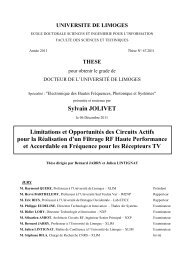Contribution à la conception optimale en terme de linéarité et ...
Contribution à la conception optimale en terme de linéarité et ...
Contribution à la conception optimale en terme de linéarité et ...
You also want an ePaper? Increase the reach of your titles
YUMPU automatically turns print PDFs into web optimized ePapers that Google loves.
CHAPITRE II – CONSIDERATIONS GENERALES SUR LA LINEARITE DES AMPLIFICATEURS DE PUISSANCE<br />
0,7<br />
0,6<br />
0,5<br />
0,4<br />
0,3<br />
0,2<br />
0,1<br />
D<strong>en</strong>sité <strong>de</strong> probabilité<br />
DP statistique<br />
DP temporelle<br />
Loi normale<br />
0<br />
-3 -2 -1 0 1 2 3<br />
Figure II.11 – D<strong>en</strong>sité <strong>de</strong> probabilité d’un signal composé <strong>de</strong> 100 porteuses<br />
II.5.2.2. - Calcul du bruit d’intermodu<strong>la</strong>tion<br />
La technique analytique d’évaluation <strong>de</strong>s produits d’intermodu<strong>la</strong>tion <strong>à</strong> <strong>la</strong> sortie d’une<br />
fonction non-linéaire modélisée par son développem<strong>en</strong>t limité perm<strong>et</strong> d’extraire directem<strong>en</strong>t<br />
le signal utile <strong>de</strong> <strong>la</strong> distorsion. Cep<strong>en</strong>dant <strong>la</strong> complexité du développem<strong>en</strong>t formel ne perm<strong>et</strong><br />
pas d’ét<strong>en</strong>dre c<strong>et</strong>te métho<strong>de</strong> aux applications réelles.<br />
Dans <strong>la</strong> pratique, <strong>la</strong> réponse du système non linéaire est évaluée <strong>à</strong> l’ai<strong>de</strong> d’un<br />
simu<strong>la</strong>teur numérique. La discrimination <strong>en</strong>tre distorsion <strong>et</strong> signal utile est alors généralem<strong>en</strong>t<br />
difficile. La distinction <strong>en</strong>tre le signal utile <strong>et</strong> le bruit doit être opérée <strong>à</strong> posteriori. Deux<br />
techniques sont <strong>à</strong> l’usage <strong>à</strong> ce jour [10] [14]. La première est basée sur <strong>la</strong> construction d’un<br />
signal d’excitation sur une répartition <strong>de</strong> fréqu<strong>en</strong>ces non comm<strong>en</strong>surables. La secon<strong>de</strong><br />
consiste <strong>à</strong> recueillir les produits d’intermodu<strong>la</strong>tion dans une zone dépourvue <strong>de</strong> porteuses<br />
(donc <strong>de</strong> signal utile).<br />
II.5.2.2.1. - Métho<strong>de</strong> par répartition non comm<strong>en</strong>surable <strong>de</strong>s porteuses<br />
Comme il a été indiqué dans les paragraphes précéd<strong>en</strong>ts, les produits<br />
d’intermodu<strong>la</strong>tion gênants sont les produits d’ordre impair car ils r<strong>et</strong>omb<strong>en</strong>t dans <strong>la</strong> ban<strong>de</strong> <strong>de</strong><br />
l’amplificateur. Lorsque l’amplificateur non linéaire est excité par un grand nombre <strong>de</strong><br />
porteuses, certains produits d’intermodu<strong>la</strong>tion peuv<strong>en</strong>t r<strong>et</strong>omber sur les fréqu<strong>en</strong>ces porteuses.<br />
Il est alors impossible <strong>de</strong> les dissocier <strong>à</strong> l’ai<strong>de</strong> d’une analyse spectrale aveugle. La technique<br />
du p<strong>la</strong>n <strong>de</strong> répartition non comm<strong>en</strong>surable <strong>de</strong>s porteuses consiste <strong>à</strong> choisir <strong>de</strong>s distances inter<br />
61
















